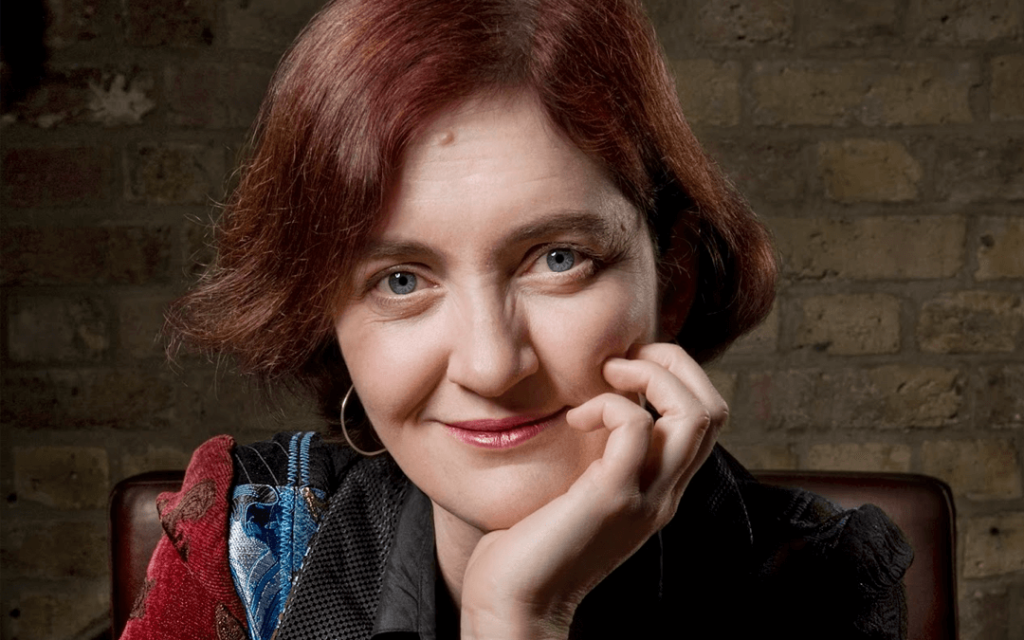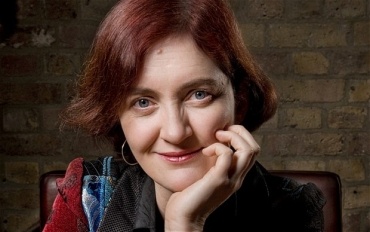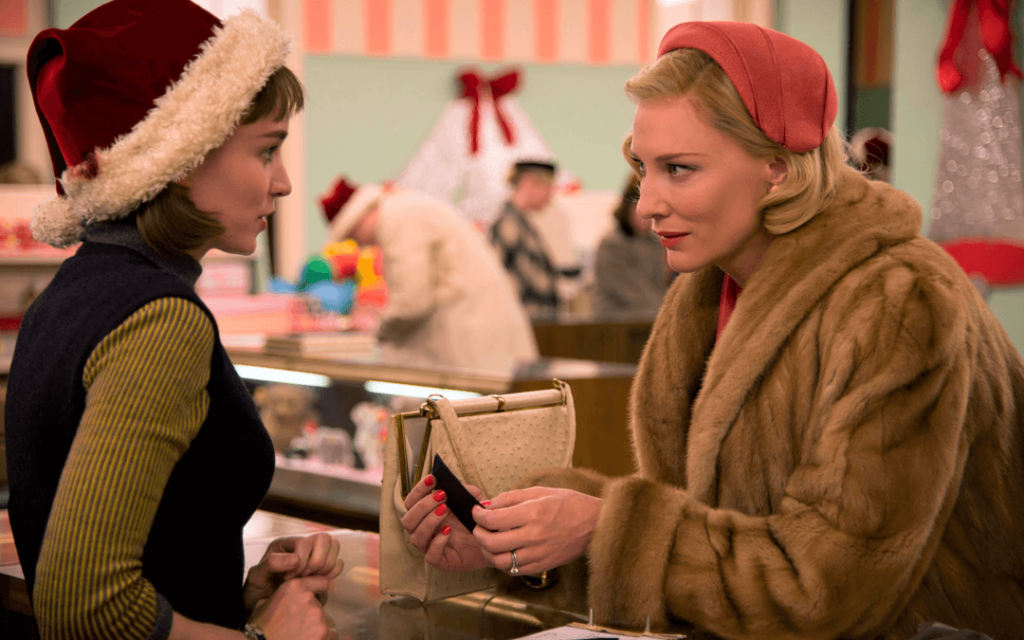Phyllis Nagy talks about her 18-year journey to making her new film Carol
December 4, 2015
By Shanee Edwards
Despite having a successful career as a playwright, Phyllis Nagy is best known for her 2005 film Mrs. Harris, starring Annette Benning and Ben Kingsley. She’s now adapted Patricia Highsmith’s 1952 novel The Price of Salt into the new film Carol, directed by Todd Haynes, and critics are raving.
Starring Cate Blanchett and Rooney Mara, Carol currently has a Rotten Tomatoes score of 94%, which is a big deal for a small film about two women, particularly two women who are lesbians. With Caitlyn Jenner paving the way for transgendered people, and gay marriage finally legal, I asked Nagy why Carol is an important movie in 2015.
“I wonder if there’s ever a moment when the examination of the human heart isn’t an important story. Of course, this story’s protagonists are two women who are gay in a world in which this is not necessarily ordinary in either of their social circumstances, so that takes on a particular significance,” said Nagy.
Though she says we’ve moved into a time period where people like Carol (Blanchett) and Terese (Mara) could get married, there still remains a lot of prejudice.
“I think we’re kidding ourselves if we believe there is a widespread acceptance of their relationship, or what is condescendingly referred to as a ‘lifestyle choice.’ And there are parts of (California) where, if they checked into a hotel, people would look at them funny. So have we really overcome any obstacles in terms of acceptance? I don’t think so. There are places in America where people are murdered still,” said Nagy.
The thing that makes both Carol and Terese so relatable is their willingness to fall in love, even if it means traveling down a difficult road. “We never question our choices when we’re in love. We’re reckless. We make good and bad decisions. If people will watch the film and be moved by it, it’s a huge achievement. I’d be happy with that,” said Nagy.
But Carol wasn’t an easy film to get made. In fact, it’s been 18 years since Nagy was commissioned to write the first draft. “I was given great freedom and flexibility to write the kind of script I wanted. Everything was in place for it to be nurtured, supported, and then… If you think back to what film financing was like in say, late 1997, this was a time where Cate Blanchett wasn’t Cate Blanchett, at least not in the way we know her now. The people who made decisions about what films to finance, weren’t making movies like this.”
Nagy insists that it wasn’t the gay aspect of the film that kept it from getting made. “It’s the women, not the lesbian women, and a third supporting female, and only two or three supporting roles for men, that made it impossible to finance. I’m not sure it’s changed all that much. What has changed is that there are a few people willing to take a chance, and if you got actors of the caliber of Cate and directors of the caliber of Todd (Haynes), you can cobble it together. But it was still a struggle.”
For being a love story, the film has very little sex, none of it onscreen. I asked Nagy if that was her choice. She said yes, adding, “There have been directors who were attached over the years who’ve said, Well, wouldn’t it be nice if they had two weeks together, tumbling into bed in different hotel rooms before they get caught. And I was horrified by that suggestion because I knew it was wrong. Sometimes you can’t articulate why something is wrong beyond, well, that’s the way it is in the novel. And it is, actually, but metaphorically, it is completely emotionally correct for them to be able to consummate their love, but to have that menace behind them, so they have to work their way through it. They do have one more night together, which is a very different kind of night, but still one that I think is more important because it’s Carol who says, ‘PI’s and husbands be damned.’”
Nagy she both she and Haynes consciously avoided deferring to 21st century attitudes when it comes to sex. “I think our senses have been dulled generally by too much sex in movies for no good reason. There has to be a really good reason for it. In this case, the movie has been building to that shared moment of intimacy and that it’s in a real place, not in a fantasy construct of four-poster beds with gauze, music and sexy nightgowns. Instead, it’s just some crappy radio in a horrible-looking room with luggage on the next bed. It’s wonderful, I love the way that was shot. It leaves you probably wanting them to have more, which is exactly why just one unencumbered scene works. So you want them to get together again.”
In real life, author Patricia Highsmith served as a mentor to Nagy before her death in 1995. “She was very encouraging about introducing me to people. She was very generous in that way. She had been going at it alone as a young person. She was a great inspiration.”
Nagy admits knowing Highsmith helped her in writing the script. “Pat is all over the character of Terese in that book - I see her, I hear her, I know that she was writing about herself. It helped me to create that character in a big way.”
While the character Terese was clear to Nagy, the character of Carole was a bit more complicated and, at times, she comes off as a bit gruff. But Nagy says she never thinks about likability in complicated people. “She’s prickly, she’s melancholic, a little bit volatile, but look at her circumstance. Where is this coming from? If you can properly contextualize the behavior, you can create empathy, which I think is the point. If someone doesn’t like Carol, I can see that. She can be difficult, but you understand her and that is the more important thing for me.”
Nagy’s advice to writers who want to tackle unconventional or less commercial topics in their screenplays is not to worry about the marketplace. “Just write the damn script you want to write. Because if you do think about who will buy it, I can guarantee that 90 percent of the time no one will.”
Despite having a successful career as a playwright, Phyllis Nagy is best known for her 2005 film Mrs. Harris, starring Annette Benning and Ben Kingsley. She’s now adapted Patricia Highsmith’s 1952 novel The Price of Salt into the new film Carol, directed by Todd Haynes, and critics are raving.
Starring Cate Blanchett and Rooney Mara, Carol currently has a Rotten Tomatoes score of 94%, which is a big deal for a small film about two women, particularly two women who are lesbians. With Caitlyn Jenner paving the way for transgendered people, and gay marriage finally legal, I asked Nagy why Carol is an important movie in 2015.
“I wonder if there’s ever a moment when the examination of the human heart isn’t an important story. Of course, this story’s protagonists are two women who are gay in a world in which this is not necessarily ordinary in either of their social circumstances, so that takes on a particular significance,” said Nagy.
Though she says we’ve moved into a time period where people like Carol (Blanchett) and Terese (Mara) could get married, there still remains a lot of prejudice.
“I think we’re kidding ourselves if we believe there is a widespread acceptance of their relationship, or what is condescendingly referred to as a ‘lifestyle choice.’ And there are parts of (California) where, if they checked into a hotel, people would look at them funny. So have we really overcome any obstacles in terms of acceptance? I don’t think so. There are places in America where people are murdered still,” said Nagy.
The thing that makes both Carol and Terese so relatable is their willingness to fall in love, even if it means traveling down a difficult road. “We never question our choices when we’re in love. We’re reckless. We make good and bad decisions. If people will watch the film and be moved by it, it’s a huge achievement. I’d be happy with that,” said Nagy.
But Carol wasn’t an easy film to get made. In fact, it’s been 18 years since Nagy was commissioned to write the first draft. “I was given great freedom and flexibility to write the kind of script I wanted. Everything was in place for it to be nurtured, supported, and then… If you think back to what film financing was like in say, late 1997, this was a time where Cate Blanchett wasn’t Cate Blanchett, at least not in the way we know her now. The people who made decisions about what films to finance, weren’t making movies like this.”
Nagy insists that it wasn’t the gay aspect of the film that kept it from getting made. “It’s the women, not the lesbian women, and a third supporting female, and only two or three supporting roles for men, that made it impossible to finance. I’m not sure it’s changed all that much. What has changed is that there are a few people willing to take a chance, and if you got actors of the caliber of Cate and directors of the caliber of Todd (Haynes), you can cobble it together. But it was still a struggle.”
For being a love story, the film has very little sex, none of it onscreen. I asked Nagy if that was her choice. She said yes, adding, “There have been directors who were attached over the years who’ve said, Well, wouldn’t it be nice if they had two weeks together, tumbling into bed in different hotel rooms before they get caught. And I was horrified by that suggestion because I knew it was wrong. Sometimes you can’t articulate why something is wrong beyond, well, that’s the way it is in the novel. And it is, actually, but metaphorically, it is completely emotionally correct for them to be able to consummate their love, but to have that menace behind them, so they have to work their way through it. They do have one more night together, which is a very different kind of night, but still one that I think is more important because it’s Carol who says, ‘PI’s and husbands be damned.’”
Nagy she both she and Haynes consciously avoided deferring to 21st century attitudes when it comes to sex. “I think our senses have been dulled generally by too much sex in movies for no good reason. There has to be a really good reason for it. In this case, the movie has been building to that shared moment of intimacy and that it’s in a real place, not in a fantasy construct of four-poster beds with gauze, music and sexy nightgowns. Instead, it’s just some crappy radio in a horrible-looking room with luggage on the next bed. It’s wonderful, I love the way that was shot. It leaves you probably wanting them to have more, which is exactly why just one unencumbered scene works. So you want them to get together again.”
In real life, author Patricia Highsmith served as a mentor to Nagy before her death in 1995. “She was very encouraging about introducing me to people. She was very generous in that way. She had been going at it alone as a young person. She was a great inspiration.”
Nagy admits knowing Highsmith helped her in writing the script. “Pat is all over the character of Terese in that book - I see her, I hear her, I know that she was writing about herself. It helped me to create that character in a big way.”
While the character Terese was clear to Nagy, the character of Carole was a bit more complicated and, at times, she comes off as a bit gruff. But Nagy says she never thinks about likability in complicated people. “She’s prickly, she’s melancholic, a little bit volatile, but look at her circumstance. Where is this coming from? If you can properly contextualize the behavior, you can create empathy, which I think is the point. If someone doesn’t like Carol, I can see that. She can be difficult, but you understand her and that is the more important thing for me.”
Nagy’s advice to writers who want to tackle unconventional or less commercial topics in their screenplays is not to worry about the marketplace. “Just write the damn script you want to write. Because if you do think about who will buy it, I can guarantee that 90 percent of the time no one will.”
Carol opens in theaters on Friday, Nov. 20.
Written by: Shanee Edwards
Shanee Edwards is an L.A.-based screenwriter, journalist and novelist who recently won The Next MacGyver television writing competition to create a TV show about a female engineer and was honored to be mentored by actress/producers America Ferrera. Shanee's first novel, Ada Lovelace: The Countess Who Dreamed in Numbers was published by Conrad Press in 2019. Currently, she is working on a biopic of controversial nurse Florence Nightingale. Shanee’s ultimate goal is to tell stories about strong, spirited women whose passion, humor and courage inspire us all.- Topics:
- Industry Interviews & Spotlights




